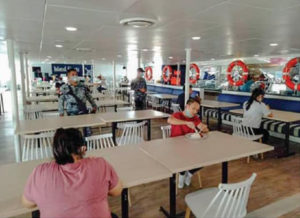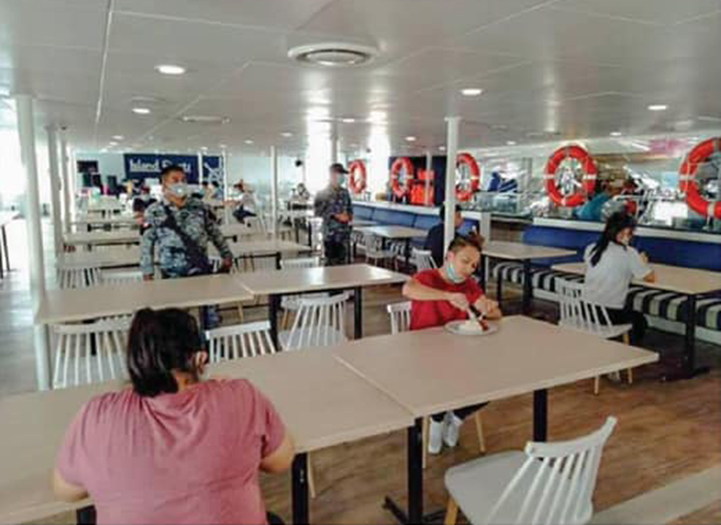 Passenger ships can only carry 50% of their capacity, the same load allowed for public utility vehicles such as buses and jeepneys during the general community quarantine (GCQ) period.
Passenger ships can only carry 50% of their capacity, the same load allowed for public utility vehicles such as buses and jeepneys during the general community quarantine (GCQ) period.
These are just some of the rules contained in the Omnibus Public Transport Guidelines set recently by the Department of Transportation (DOTr) and the Inter-Agency Task Force for the Management of Emerging Infectious Diseases (IATF-EID) covering the road transport, aviation, maritime and railways sectors.
READ: Public transport running at half capacity in GCQ areas
The rules are meant to stem the spread of the coronavirus disease.
Other regulations include electronically filling out Health Declaration and Passenger Locator Forms for arriving and departing airport passengers, and accomplishing health protocol forms upon entry in seaport premises and terminals.
Everyone must also wear a face mask, face shield or other personal protective equipment at air and seaports. Social distancing measures should be strictly observed by all sectors.
Mandatory checking of body temperature will be conducted at airports, seaports and terminals.
Regular disinfection and sanitation of airports, seaports, terminals, and public utility vehicles should be conducted.
All modes of public transportation in areas under the extended enhanced community quarantine (ECQ), including Metro Manila, remain prohibited.
Operations of LRT-1, LRT-2, MRT-3 and PNR will be limited after the lifting on May 16, 2020 of the ECQ.
In the aviation sector, the following flights are allowed to operate for areas under GCQ:
1) Government and military flights;
2) International flights subject to existing IATF-EID/Bureau of Quarantine protocols;
3) Air ambulance and medical supplies;
4) Flight check and weather mitigation flights;
5) Maintenance and utility flights;
6) Emergency flights; domestic flights coming to and from provinces and cities under GCQ, subject to required airport clearances and flight plan approvals, as maybe applicable; and
7) Other flights (as approved by IATF-EID).
Only passengers with valid travel documents will be allowed to enter airport premises.
Security procedures will be done through “no contact means” but not limited to the use of walk through x-ray machines, portable scanners, and handheld metal detectors, among others.
Close contact security screening by means of pat down/manual frisking is limited to exceptional situations.
Disinfecting facilities established in terminals will be equipped with alcohol and/or soap. Foot baths will be installed in all entry and exit points of passengers and airport personnel, including boarding bridges and/or similar areas for passenger embarkation/disembarkation to and from the aircraft. All airport facilities and equipment, including lavatories, frequently touched surfaces, wheelchairs, trolleys, countertops, etc., will be regularly disinfected and sanitized.
Road sector
In the road sector, the passenger load for public utility buses and public utility jeepneys (PUJs) should not exceed 50% of the vehicle’s capacity, excluding driver and conductor.
For UV Express and taxis, passenger load should not exceed two passengers per row, except for the driver’s row where only one passenger is allowed.
Tricycles must not exceed one passenger in the side car; backriding is disallowed.
Private cars and motorcycles will be allowed to operate but only for essential travels as defined by the IATF.
Private cars will only be allowed one passenger to occupy the front passenger seat, while front-facing seats will not exceed two passengers per row.
Motorcycles are prohibited from having backride passengers.
The use of bicycles and similar devices are highly encouraged. Local government units are encouraged to identify bike lanes, or bike-only roads.
Drivers are required to use face masks and gloves.
The mode of PUV that will operate in each route in GCQ areas will be guided by the number of passengers that will be transported.
PUVs with higher passenger capacity such as buses will be prioritized. In areas where buses are not enough to serve the actual passenger demand, or the road characteristics will not permit their operations, PUV Modernization Program-compliant PUVs are the next priority.
In areas with unavailable buses and modern PUVs, PUJs and UV Express may operate.
In areas where no other mode of public transportation is available, tricycles may be permitted to operate as determined by the Land Transportation Franchising and Regulatory Board (LTFRB) in coordination with the corresponding LGU.
Drivers and operators must apply for a special permit to operate, free of charge, through LTFRB offices or by email through LTFRB’s online channels.
Rail operations
When operations of LRT-1, LRT-2, MRT-3 and PNR resume, the following passengers will not be allowed to enter the station: 1) Passengers not wearing proper face mask; 2) Passengers showing COVID-19 symptoms or with a registered body temperature of 37.8°C or higher; and 3) Senior citizens, passengers aged 0-20, and pregnant women due to their susceptibility to COVID-19.
Photo courtesy of the Department of Transportation





